#water wagons 1925
Text
From Sept. 2022:
SACRAMENTO, Calif. — A record-setting heat wave made life miserable in much of the West on Tuesday, with California stretching into its second week of excessive heat that taxed the state's power supply and threatened power shortages that could prompt blackouts while people were desperately trying to stay cool.
The California Independent System Operator, the entity that oversees the state's electrical grid, said there could be "rotating power outages" Tuesday evening when demand for power could reach an all-time high.
Democratic Gov. Gavin Newsom urged residents to conserve, warning in a video message that "the risk for outages is real and it's immediate."
"This heat wave is on track to be both the hottest and the longest on record for the state and many parts of the West for the month of September," Newsom said. "Everyone has to do their part to help step up for just a few more days."
California's state capital of Sacramento tied a record Tuesday with its 41st day of temperatures reaching at least 100 degrees Fahrenheit (38 degrees Celsius). And there was a chance the city would break its all-time high temperature of 114 degrees Fahrenheit (46 degrees Celsius) set in 1925, according to the National Weather Service.
Sacramento native Debbie Chang was out walking in Capitol Park on Tuesday morning, pulling a wagon of Pop-Tarts and water to hand out to homeless people. She lives in an old house that relies on wall-mounted units that she says don't work so well. The temperature reached 91 degrees (33 C) in her house Monday night.
"The past few years in California, it's really rough," she said. "I really love this state. And growing up I never imagined I'd exactly want to live outside of California, unless maybe internationally. But this is very difficult."
In neighboring Nevada, Reno set a record of 102 degrees (39 C) on Monday while in Utah's Salt Lake City temperatures were about 20 degrees higher than normal, hitting 105 degrees (40.5 C) on Tuesday, the hottest September day recorded going back to 1874.
Scientists say climate change has made the West warmer and drier over the last three decades and will continue to make weather more extreme and wildfires more frequent and destructive. In the last five years, California has experienced the largest and most destructive fires in state history.
A wildfire that started Friday in the Northern California community of Weed killed two people and one that erupted Monday and spread rapidly in the Hemet area of Southern California also killed two people. Authorities said they were found in the same area and apparently died while trying to flee the flames.
Though the heat wave was likely to peak in most places on Tuesday, extremely high temperatures are expected to continue for several more days.
"It is a genuinely dangerous event from a human health perspective," said Daniel Swain, a climate scientist with the University of California, Los Angeles Institute for Environment and Sustainability
Sacramento County officials were using the air-conditioned lobbies of some of their public buildings as cooling centers for people with nowhere else to go and offering free transportation for people who could not get there. Officials even handed out motel vouchers to some homeless people through a program they normally reserve for the winter, according to county spokeswoman Janna Haynes.
"While a lot of people can stay home, a lot of people do not have a home to stay in," Haynes said.
In state office buildings, thermostats were being set at 85 degrees (29 C) at 5 p.m. to conserve electricity.
Sacramento native Ariana Clark said she couldn't remember it ever being this hot for this long before. She said she turned her air conditioner off in the afternoons to conserve energy and kept her 9-month old son, Benito, cool by filling up a bucket for him to play in outside.
"As long as he's keeping cool that's all that matters," Clark said.
Juliana Hinch, who moved to Sacramento from San Diego 2 1/2 years ago said she has never seen heat like this before. She said some wetlands by her house have mostly dried up, so she leaves water in her front yard "for other random animals," including cats, squirrels and coyotes.
Hinch said she once lived in Washington state but moved away because it was too cold. Now, she said "that sounds like a good problem to have."
California and the West broil in record-setting heat wave https://www.npr.org/2022/09/06/1121403326/california-and-the-west-broil-in-record-setting-heat-wave
Copyright 2022 The Associated Press. To see more, visit The Associated Press.
6 notes
·
View notes
Text
[ad_1]
Rick Fitzpatrick holds a canine after evacuating from the Fairview Fire on Monday, Sept. 5, close to Hemet, Calif.
Ethan Swope/AP
cover caption
toggle caption
Ethan Swope/AP
Rick Fitzpatrick holds a canine after evacuating from the Fairview Fire on Monday, Sept. 5, close to Hemet, Calif.
Ethan Swope/AP
SACRAMENTO, Calif. — A record-setting warmth wave made life depressing in a lot of the West on Tuesday, with California stretching into its second week of extreme warmth that taxed the state's energy provide and threatened energy shortages that might immediate blackouts whereas folks have been desperately making an attempt to remain cool. The California Independent System Operator, the entity that oversees the state's electrical grid, stated there could possibly be "rotating power outages" Tuesday night when demand for energy might attain an all-time excessive. Democratic Gov. Gavin Newsom urged residents to preserve, warning in a video message that "the risk for outages is real and it's immediate." "This heat wave is on track to be both the hottest and the longest on record for the state and many parts of the West for the month of September," Newsom stated. "Everyone has to do their part to help step up for just a few more days." California's state capital of Sacramento tied a report Tuesday with its forty first day of temperatures reaching no less than 100 levels Fahrenheit (38 levels Celsius). And there was an opportunity the town would break its all-time excessive temperature of 114 levels Fahrenheit (46 levels Celsius) set in 1925, based on the National Weather Service.
Sacramento native Debbie Chang was out strolling in Capitol Park on Tuesday morning, pulling a wagon of Pop-Tarts and water handy out to homeless folks. She lives in an outdated home that depends on wall-mounted items that she says do not work so nicely. The temperature reached 91 levels (33 C) in her home Monday evening. "The past few years in California, it's really rough," she stated. "I really love this state. And growing up I never imagined I'd exactly want to live outside of California, unless maybe internationally. But this is very difficult." In neighboring Nevada, Reno set a report of 102 levels (39 C) on Monday whereas in Utah's Salt Lake City temperatures have been about 20 levels larger than regular, hitting 105 levels (40.5 C) on Tuesday, the most well liked September day recorded going again to 1874. Scientists say local weather change has made the West hotter and drier over the past three many years and can proceed to make climate extra excessive and wildfires extra frequent and harmful. In the final 5 years, California has skilled the biggest and most harmful fires in state historical past.
Firefighters coordinate efforts at a burning property whereas battling the Fairview Fire on Monday, Sept. 5, close to Hemet, Calif.
Ethan Swope/AP
cover caption
toggle caption
Ethan Swope/AP
A wildfire that began Friday within the Northern California group of Weed killed two folks and one which erupted Monday and unfold quickly within the Hemet space of Southern California additionally killed two folks.
Authorities stated they have been present in the identical space and apparently died whereas making an attempt to flee the flames.
Though the warmth wave was more likely to peak in most locations on Tuesday, extraordinarily excessive temperatures are anticipated to proceed for a number of extra days. "It is a genuinely dangerous event from a human health perspective," stated Daniel Swain, a local weather scientist with the University of California, Los Angeles Institute for Environment and Sustainability Sacramento County officers have been utilizing the air-conditioned lobbies of a few of their public buildings as cooling facilities for folks with nowhere else to go and providing free transportation for individuals who couldn't get there. Officials even handed out motel vouchers to some homeless folks by way of a program they usually reserve for the winter, based on county spokeswoman Janna Haynes. "While a lot of people can stay home, a lot of people do not have a home to stay in," Haynes stated. In state workplace buildings, thermostats have been being set at 85 levels (29 C) at 5 p.m. to preserve electrical energy. Sacramento native Ariana Clark stated she could not keep in mind it ever being this sizzling for this lengthy earlier than. She stated she turned her air conditioner off within the afternoons to preserve power and stored her 9-month outdated son, Benito, cool by filling up a bucket for him to play in outdoors. "As long as he's keeping cool that's all that matters," Clark stated. Juliana Hinch, who moved to Sacramento from San Diego 2 1/2 years in the past stated she has by no means seen warmth like this earlier than. She stated some wetlands by her home have largely dried up, so she leaves water in her entrance yard "for other random animals," together with cats, squirrels and coyotes. Hinch stated she as soon as lived in Washington state however moved away as a result of it was too chilly. Now, she stated "that sounds like a good problem to have."
[ad_2]
Source link
0 notes
Text
Wesley Chapel

Wesley Chapel is an unincorporated census-designated place of 6.1 square miles at the southern border of Pasco County near I-75 and I-275. In 2010, the US Census recorded 44,092 residents. It is one of the fastest growing areas in the United States.
John Boyette was born in 1875, the son of John “Berry” Boyette and nephew of Thomas Ashley Boyette. He is shown with his wife Blanche, and children, Johnnie, William, Ruby, and Vera. Photo courtesy of Cletia Pierce, from Images of America: Wesley Chapel by Madonna Jervis Wise. (e2679)
The pioneer Boyett(e), Gillett(e), Godwin, and Kersey
families received land grants in the area in the 1840s. The real influx of
settlers, however, began around the War Between the States when the Stanleys
and Coopers arrived.
A historical marker has: “Originally called Double Branch for the twin creeks that flowed across the Boyette land, the community was named for the Methodist chapel that stood on the northwest corner of SR 54 and Boyette Road.”
The church itself was named for John Wesley, the founder of the Methodist movement. The name “Wesley Chapel” appears in Hernando County school board records from 1877-1878. At this time, Pasco and Citrus Counties were united as part of Hernando County.
Previous Names for Wesley Chapel
Alligator hunting in the swamps of Wesley Chapel. Lonnie Tucker on far left is guiding the two visitors through the swamp. Photo courtesy of his daughter Anna Jo Bracknell, who said it was typical for him to harvest 3 to 4 gators per evening. From Images of America: Wesley Chapel, by Madonna Jervis Wise. (e2656)
A popular nickname for the area at that time was Gatorville. It was not because of University of Florida either.
In September of 1887 voting precincts were established for
the newly-formed Pasco County. Wesley Chapel was designated Precinct 4.
A post office operated in the area from 1897 to 1902. The post office was called “Wesley,” and maps during that period have the shortened name “Wesley” and some school board minutes also used the shortened name.
Since its founding in 1878, the Double Branch Baptist Church (now the First Baptist Church) has served as a focus for Wesley Chapel community life. The church has had three buildings in its long history. Henry Ryals was pastor in the first building in 1880, Ed Bryant the second in 1935, and Lynn Foster the third in 1970.
Early Wesley Chapel Industries
Cuts Manning, a log roller at the sawmill. (Florida State Archives)
The turpentine still and sawmill represented early industries, though cattle ranching and hog farming on the then open range, crop farming, and citrus growing predominated. When times were hard people turned to charcoal making and even moonshining to survive.
Most roads began as wagon tracks between the farms and ranches and the locations where goods were sold. Eventually these were improved, paved and today have names like State Road 54!
Born on July 25, 1876 in Quitman, Georgia. Moved to Pasco County as a young man and married Ellen Osburn. Agent Waters was shot and killed along with Pasco County Deputy Sheriff Arthur F. Crenshaw from ambush on October 4, 1922. They were returning from a ranch after completing the execution of a search warrant for bootleg liquor. The name of John V. Waters is inscribed (East Wall, Panel 27, Line 5) on the National Law Enforcement Memorial in Washington, D.C. (State of Florida Archives)
In 1925, there were 3 incidences of arrests, deaths and illegal moonshine production in Wesley Chapel reported in the Tampa and Dade City newspapers. The moonshine operations continued through 1927, with Federal Marshalls uncovering numerous stills and confiscating thousands of gallons of liquor and mash.
Moonshine and a still in the attic. (Florida State Archives)
A prominent local name, Strickland, and a Sicilian distiller named Sangiorgi were some of the many people whose copper stills, liquor, weapons, and mash were confiscated from the local swamps and deep woods during Prohibition.
Wesley Chapel begins Growth with Electricity in the 1940s
Luther Daniel Smith was instrumental in bringing electricity
to the community of Wesley Chapel in 1940s while he served on the Withlacoochee
River Electric Cooperative Board.
In 1956, the Highway 54 West Bridge was built west of the
Eagles Flea Market. The 1960s saw the construction of I-75, connecting the area
with travelers from the north and south.
Double Branch Baptist Church Groundbreaking. Photo provided by Madonna Jervis Wise, author of Images of America: Wesley Chapel. (e2651)
In 1971, a new sanctuary was built for the Double Branch
Baptist Church and the former one was torn down.
The Wesley Chapel pioneer cracker home of Daniel Smith, built in 1894, was donated to Cracker Country in 1979. This hands-on museum is housed at the Florida State Fairgrounds, Smith House, and shares the story of frontier life in Wesley Chapel.
Saddlebrook Resort post card, about 1982.
Saddlebrook Resort formally opened in 1981, with a car-free walking
village design, allowing guests to walk throughout the resort without the need
of a transportation system while providing sanctuary to nature. Thomas L. Dempsey
was the visionary for this award-winning golf and tennis resort in Wesley
Chapel.
Wesley Chapel's Education and Housing
Wesley Chapel School (1926-27) The two-room schoolhouse was located where the current parking lot of the current First Baptist Church of Wesley Chapel (off SR 54) now is situated. It would be the parking lot to the left of the church if you are facing the front of the church. One room was designated for the 1st through 4th grades and the second room was for the 5th through 8th grades. Photo courtesy of Wayne Sweat, from the new book "Images of America - Wesley Chapel" by Madonna Jervis Wise. (e839)
Wesley Chapel began growing at an unprecedented rate about
this time. 1998 saw the construction of the Sand Pines Elementary School, the
community’s first modern school. Today there are eight public elementary
schools in Wesley Chapel, as well as two middle schools and two high schools.
In fact, the Double Branch Baptist Church was renamed the First Baptist Church
in 1999, the same year as Wesley Chapel High School opened.
In 2006, Wiregrass Ranch High School opened to meet the growing demand of families moving to Wesley Chapel. There are many housing and apartment complexes that were built on the ranches and farms of yesteryear.
Epperson Ranch opened with the Crystal Lagoon in Wesley Chapel.
In 2018, Epperson Ranch opened the Crystal Lagoon, the first
man-made clear water lagoon in the U. S. This 7.5 acre freshwater lagoon is
available to both residents of the Epperson Ranch and the public.
Wesley Chapel's Shopping and Dining
The first outdoor mall to be built in the area is The Grove, a 445,000 square foot complex that includes a Cinebistro movie and dining theater. The Grove is located in the northeast quadrant of I-75 and State Road 54.
Enjoy dining served at the movie theater at the Cobb Theater in The Grove shopping center.
One of those is Wiregrass Ranch, a 5,000-acre ranch that was owned by the Porter Family. In 2008, The Shops of Wiregrass, an open-air retail and entertainment destination located on the corner of State Road 56 and Bruce B. Downs Boulevard, opened there.
The Shops of Wiregrass is a popular Wesley Chapel shopping and dining destination.
Florida Hospital Wesley Chapel opened a $150-million hospital
and wellness center on part of the land in 2012.
In 2015, the Tampa Premium Outlets shopping mall brought
discount designer retail to the area and continued the wave of development to
the west side of I-75/I-275.
The abundance of state-of-the-art retailers, restaurants and
amenities have caught the eye of people from around the world who seem to be
moving to Wesley Chapel in droves.
Wesley Chapel's Sports Tradition Continues
The largest hockey complex in the southeast U.S., premiere golf and tennis academies and more make Wesley Chapel a great place to grow your sports skills!
The largest hockey complex in the southeast United States is
in Wesley Chapel. Advent Health Center Ice was opened at I-275 and State Road
56 in 2017. It has four full-sized ice rinks, as well as a kid-sized rink and
offers classes in figure skating, hockey, curling as well as tournaments, open
skates and dry rink activities. Rentals and events are available.
Saddlebrook has continued its tradition of tennis and golf education, opening the Saddlebrook Preparatory Academy to provide an accredited comprehensive education program while they are attending the Saddlebrook Tennis Program or Golf Academy
Wesley Chapel is an unincorporated area at the southern border of Pasco County, approximately midway between the east and west borders. It is a unique part of Florida's Nature Coast. Arkyan
Is Wesley Chapel part of the Nature Coast?
Wesley Chapel continues to grow in population and amenities.
In an area that was pre-designated for economic growth and development, the
Connected City is focused on the next-generation experience of its residents.
This is not simply rooftops, streets and commerce, this is Smart Homes,
autonomous vehicle paths and a business core designed to attract and support
the best and brightest, according to Pasco County.
And, though Wesley Chapel seems more like a bedroom community of Tampa, its location within Pasco County makes it part of Florida’s Nature Coast. There is certainly a lot of shiny new stuff there along with a history that is common to the rest of our area.
Wesley Chapel is one of the fastest growing areas of Florida with tons of options and amenities. Image courtesy of Pixabay
My eldest son chose to live in Wesley Chapel, even though he
was raised in Brooksville. As a young man, it was more appealing to him to live
in a multi-story apartment complex with twenty chain restaurants that will
deliver to him at any time. He still loves to come out and kayak, fish and walk
in the woods. He would rather drive to the outdoor recreation. I would rather drive
to the shopping and restaurants.
Florida’s Nature Coast has it all and Wesley Chapel is an important
part of that.
Read the full article
0 notes
Text


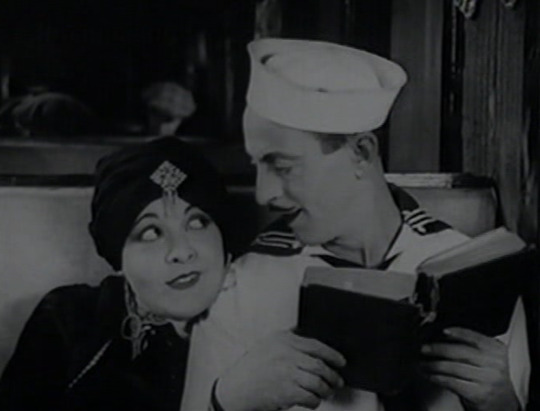
Hurlock's bee-stung lips, curly brunette hair and icy looks were seen in over 50 Sennett-Pathé shorts during 1923-28. Though best known for her comic vamp characters, she could also played a queen or a blue-collar girl with equal ease - getting a chance to play comedy leads in some of her later films, in which she was teamed with Eddie Quillan.
Away from Sennett, she appeared in the feature Don Juan's Three Nights(1926), and in the first film which she was teamed with Laurel and Hardy were teamed, Duck and Soup(1927).
Sennett called the girl from Federalsburg, Maryland, "the wittiest of bathing beauties." After attending Neff College in Philadelphia, she entered the stock company at the Little Theater in that city. Moving to New York, she spent a season on the "Century Roof" and for a time held a job as "Miss Java."
Her first film work came as an extra at Universal in the summer of 1917, after which she married a sergeant of the U.S. cavalry, John Sterling McGovern. She reentered films with a contract at Famous Players, where she reportedly appeared in The Cheat with Pola Negri in 1923, but by the spring of that year she signed at contract with Sennett paying her 150$ per week.
Hurlock was a 1925 Wampas Baby Star. Among those also appreciating her wit were respected American writers Marc Connelly and Robert E. Sherwood, who both married the woman who once cited George Eliot, Leo Tolstoy, Henrik Ibsen, Joseph Conrad and Honore de Balzac as her favorite authors in a Sennett publicity release.
Hurlock left Sennett in early 1928 to travel abroad, and married Connelly on Oct 4, 1930 in New York. In 1935, she divorced Connelly, and on Jun 15, 1935 in Budapest, Hungary, married his good friednd Sherwood - with whom she lived in Manhattan until his death in 1955. Hurlock died at 89 in New York City.
-Walker, B.E., 2010, Mack Sennett's Fun Factory, McFarland&Company, Inc., Publishers, pp.516~17
4 notes
·
View notes
Text
PARIS, FRANCE: “CITY OF LOVE”

It is an incredibly romantic city, and best known for its Eiffel Tower, Paris, France. It is a major European city and global center for fashion, art, closure and gastronomy. The city of love and romance that people daydreamed of long walks down the Champs-Elysees with a baguette under one arm, and maybe a croissant in the other. There's a reason Paris is one of travelers' most famous cities. The streets of Paris, known as the "City of Light" or the "City of Love," overflow with music, art, beauty, and history. Paris is a city that catches the hearts of millions every year, whether it's looking for Monet's Water Lilies at the Musée de l'Orangerie, ascending the many steps of the Sacré-Cœur, standing in wonder before the Eiffel Tower, or searching for the best crepes along the Seine. Initially, Paris was a Roman city called Lutetia. There are also a lot of places in Paris that is so trendy that every people wants to go including me of course, first is the Miss Kō, it is one of the trendy spots in Paris that is a restaurant that most of the people wants to eat because of the foods there that is so yummy and delicious. Le Comptoir Général8.6, according to Ronan F.Ronan Flynn-Curran his comment about this place is "Fantastic hip spot - part club, venue, school and cafe bar. Lots of dancing and great music once we were here". I also want to visit here to try the feeling being in there. There are a lot of places that are top trendy in Paris that I am very excited to visit the other two was mentioned above the others are Le Mary Céleste, Monsieur Bleu, Le Derrière, Daroco, Le Perchoir, Mama Shelter, Holybelly 19, Paname Brewing Company, 52 Faubourg Saint-Denis, Prescription Cocktail Club, Lomi, East Mamma, Strada Café.
The history of Paris is rich and filled with sugar and butter. and military glory, intriguing architecture, musicians, food, and fashion as well. The amazing history of Paris is that “Paris, Older Than You Think” the bones, indeed, human bones, were discovered all the way back to 8000 BC in Paris. That's during the Mesolithic period, which just happens to be right between the dull stone tools of the Old Stone Age and the polished stone tools of the Modern Stone Age. Paris was the largest and most populous city in all of Europe during the Middle Ages, also known as the medieval era. It lasted from the 5th to the 15th century, if you want to draw up your handy-dandy mental timeline. Paris is proud to have founded the University of Paris in 1150 as the second university in all of Europe. Paris became Europe's book-publishing city during the 16th century. And according to a study, the Paris Catacombs hold the bodies of more than six million dead people. After a basement wall collapsed in a cemetery in 1774, work started on the catacombs, and good ol 'King Louis XVI discovered that there were just not enough cemeteries for all his dead subjects. There was a regular procession of wagons beginning in 1786, carrying skeletons from the graveyard to a mine shaft, deep down into the catacombs. In 1892, Vogue was created and fashion houses were founded by Jacques Doucet and Madeline Vionnet. By popularizing the casual chic look as the feminine standard of style, Coco Chanel stepped into the fashion spotlight in 1925.
There are currently 130 museums in Paris, including the Musée de la Magie (Musée de la Magie), the Musée du Fumeur (Museum of Smoking), and the Musée de la Préfecture de Police (Museum of Police and Law Enforcement). And well the Louvre is there. Paris is also home to the Musée du Parfum (Perfume Museum), established by Fragonard Parfumeur in 1983. The museum, however, features displays of perfume bottles, containers, and collections of toiletries. It is also under discussion whether there is a smelling tour or not. The Louvre is the world's largest museum. It has 380,000 works of art and over 15,000 daily visitors. Originally, it wasn't a museum; it was a castle built in 1190. It was then a royal palace later on. The Louvre became a museum only when the Royals were upgraded to the Palace of Versailles. Yeah, and it's the one haunted by Belphegor's mummy.
There is one place that catches my attention and that is the place that inspired Hemingway and Balzac, impressionist paintings and love songs, everybody knows Paris. There are a lot of beautiful places in the city, like Panthéon, it is gorgeous neoclassical architecture is lure enough. Musée Rodin may be a light-filled estate with a serene garden crammed with sculptures just like the Thinker and therefore the Gates of Hell. It's as intimate and private (and relatively uncrowded) a museum-going experience as you will get within the city. Place de la Concorde, this public square is now one of the most majestic locations in Paris, considering its macabre past (it was the location of guillotine executions during the French Revolution). Landmarks such as the Luxor Obelisk and the fountain overflowing with mermaids just add to the glamour. And the next one is the Pont Alexandre III, this ornate, Beaux-Arts-style bridge links Paris' Left and Right Banks, and it is the city's largest tourist photo-ops. We catch on with all the gilded statues and views of the river, the urge to selfie is real.
Next is the Eiffel tower, this is one of my most favorite place in Paris. One of the key reasons that the Eiffel Tower is so popular is that it was considered crazy' at the time of construction as a new artistic concept. It is famous because in almost every picture taken of the Paris skyline, and in almost every movie set in this area, the tower appears. It's also one of the world's most distinctive structures, climbing it is a bucket list activity you'll never forget. Another reason the Eiffel Tower became so popular all over the world was that it was by far the tallest building in the world at the time. At 986 feet, the Eiffel Tower is almost twice the height of the previous tallest building (the Washington Monument at 555ft). It was thus towering above all else in Paris and people were in awe of the ability of this metal structure to stand alone. I have been dreaming to visit this place since I was a child. I was amazed of the picture that I have seen once when I googled about it. I’ve been dreaming about it that maybe one day I can see 100 of kilometers allowing me to take sides of Paris such as the Arc de Triomphe, Notre Dame, La defense, and Champs Elysees. The Eiffel Tower has been used in many works of artists, photographers, and film makers, which has led to its status as one of the most famous and romantic destinations in the world. The main reason that I want to visit the Eiffel tower is simply because it is so iconic and impressive structure in person. The Eiffel tower is a guy ribley more beautiful from afar or in photographs, it is truly magical experience that I want to visit one day.
#creativenonfiction
Reference
https://www.europeanbestdestinations.com/destinations/paris/
2 notes
·
View notes
Link
7 Hidden Secrets discovered about Michigan’s Sleeper State Park
Sleeper State Park Michigan was the first state park in the Thumb. It has been a place to visit for over 95 years with an excellent beach and modern campsites. Named for Michigan Governor and local businessman Albert E. Sleeper, the park is one of two state parks in the Upper Thumb. It’s one of the most widely viited parks in Southeast Michigan. The park contains impressive secrets in what is available for the veteran visitor.
#1 Sleeper State Park Is Bigger Than The Beach And Campground
Driving by the park, visitors immediately see the day-use picnic and beach area along the shoreline and the extensive 226 site campground across M-25 from the beach. That is a small slice of the park. Sleeper State Park has over 700 acres of wetlands, an ancient dune forest, a half mile of beautiful sandy beach and natural dunes guarding the shore.
Sleeper State Park Beach Access Stairs to the Beach Protect Fragile Dunes Families and groups can spend the day swimming, kayaking, and playing at the beach.
A large covered pavilion is available for rent steps away from the beach. It’s perfect if you have a large group, such as a family reunion. The beach area is known as an ideal spot for beach weddings and company picnics.
#2 Sleeper State Park Was Named For A Local Leader Who Became Governor
In 1925, the woods, dunes, and beach we see today opened as a county park. By 1927, the State of Michigan acquired the property and called it Huron State Park. In 1944, a group of Huron County citizens petitioned the state to rename the Park. The park was renamed in honor of Albert E. Sleeper, a resident and business leader in the Thumb region.
Albert E. Sleeper - Sleeper State Park, Sleeper was governor of Michigan from 1917 until 1920.
#3 You Can Camp In Relative Luxury Away From Everything Else
Sleeper State Park has arranged with a camping outfitter that offers people a more private and comfortable camping experience. It’s called “glamming”. glamming is a concept where nature meets a bit of spacious luxury. A fusion of the words glamour and camping or “glamming” is a way to authentically experience a bit of remote rustic camping in unique locations.
The glamming experience is new to Michigan’s Albert E. Sleeper State Park and Highland Recreation Area starting the summer of 2020. More information about the Sleeper-Safari Tent program is on their website.
#4 There Are Mountain Bike Trails In Sleeper State Park
Sleeper State Park Map Showing Trails
Sleeper State Park Trail Map
One of the parks’ best-kept secrets is the extensive trail system located just south of the campground. Over four miles of marked trails are available for. hiking, cross country skiing, (Which is groomed in the winter), and mountain biking.
#5 You Can Try Kayaking At Sleeper State Park Beach
Turnip Rock what to Bring Saginaw Bay is known for its sea kayaking areas. Explore the islands and inlets of Wild Fowl Bay or paddle along the sugar sand shoreline. Just a bit further north in Port Austin is two well-known Kayaker destinations of Turnip Rock and Broken Rocks. Sleeper State Park beach is also a stop on the 100-mile Tip of the Thumb Heritage Water Trail. The beach at Sleeper State Park is a perfect place to try out kayaking for the first time or to show others how it’s done. Kayaks are available for rent at the beach.
#6 There Are Archaeological Significant Sites In The Park
In a Stewardship report made in 1995 by the Michigan DNR, it noted that the potential exists for prehistoric sites in the park. Similar land formations have proven in the nearby Rush Lake State Game Area, where 36 sites have been recorded. These include prehistoric sites, as well as nineteenth and twentieth-century historic sites. Three more sites exist west of the park. One of these was found to be a large multi-component site. Its thought that smaller sites related to this large site are located in Sleeper State Park.
#7 You Can Buy A Latte Or Smoothie At The Sleeper Campground
Sleeper State Park Chuck Wagon
The Chuck Wagon at Sleeper State Park
If you get a hankering for a Latte or Frappuccino when you’re camping you’re in luck. We found the “Chuck Wagon” waiting for us in the Albert E. Sleeper State Park campground area. It’s an open-air bar with seating for 12 people. They offer coffee, frappe, and smoothies. This is a mobile food truck part of Chucks Drive-Thru Diner in Caseville State Park . This mobile bar may move on from time to time especially during the Cheeseburger Festival.
1 note
·
View note
Text
Five Opulent Wagons‐Lits Get a Final Fare of $302.000.
By Susan Heller Anderson Special to The New York Times.

MONTE CARLO, Monaco, Oct. 9—In the head? and hermetic atmosphere of moneyed elegance that is the chief attraction here, five opulent Wagon‐Lits that for decades rode the rails as part of the Orient Express were auctioned yesterday for $302,000 in what Sotheby Parke Bernet, the auctioneer, believes to be the first: train auction ever held.
A jubilant American, James Sherwood, successfully bid $104,000 for two luxury sleeping cars with rare wood marquetry panels and velvet upholstery. The washrooms of the two cars are fitted with crystal water decanters.
Albert Glatt, the managing director of a Swiss travel company, spent $60,300 for a dining car with gleaming wood panelling, red leather banquettes and ornate brass luggage racks.
André Paccard, a Frenchman, acquired the remaining two carriages for $137,700. One, an elegant Pullman car, had caught the fancy of the German Wehrmacht and was requisitioned during Word! War 11. The other—the most elaborate or the five Art Deco carriages—is a parlor car with wing armchairs designed by Rene. Prou and covered in deep gold embossed velvet. The plane wood panels are encrusted with crystal flowers. René Lalique designed the upholstery panelling.
Mr. Sherwood said that he paid about what he had planned. But Mr. Glatt observed later, in the privacy of an associate's yacht, that he thought the prices were three times what the cars were worth. “It will cost least $20,000 to restore one car;” he said.
The cars belonged to the Compagnie Internationale des Wagons‐Lits and rolled across Europe in the days of deluxe train travel. But such leisure has been replaced by jets and the Wagons‐Lits company, now celebrating its 100th birthday, decided to give up the cars.“They don't have air‐conditioning,” Jacques‐Bernard Dupont, the firm's administrative director, said. “They can't go fast enough—it's not good for them. To build such cars today would cost about $50,000 each.” He said that the company still has about 10 cars from the 1920's but none quite as opulent in decor. Both Mr. Sherwood and Mr. Glatt will put their purchases back on the tracks Mr. Glatt's company presently runs the nostalgic Orient Express, providing deluxe service from Zurich to Istanbul.
The dining car the 10th old carriage his company has bought. Mr. Sherwood, a Kentucky native living in London, is the president of Sea Containers Inc., a New York shipping firm. He hopes to start a venture similar to Mr. Glatt's, going from London to Venice via Dieppe and Paris.“We'll eventually buy 20 cars and cooperate with Mr. Glatt on rolling stock,” Mr. Sherwood said.
Mr. Paccard, the third buyer, would say only that his two cars would remain in France.In a cloud of authentic smoke from the diner's coal burning, stove, the five cars made their last run Friday from Nice to Monte Carlo, leaving 19 minutes late. The trip, which hugs the Mediterranean coastline and normally takes 20 minutes, took 54 minutes, to the astonishment of Margarete Lamboy a tourist from Hanover, West Germany, who had got on by mistake.“I just wanted to get to Monte Carlo,” she said. “And where do I pay?”The remaining 90 passengers were potential buyers, train buffs, the press and 50 friends of Princess Grace. The Princess, wearing a beige poplin Saint Laurent suit, and friends sipped fresh orange juice and nibbled buttery croissants and brioches. Waiters in starched white jackets poured café au lait from silver pots into white Limoges cups with gold monograms.
Each table had a silver bud vase filled with red roses.The train buffs, several of whom have written books this year on luxury train travel, seemed morose over the end of an era.To prolong the nostalgia, Sotheby's later in the day auctioned nearly 200 lots of furniture and objets d'art from the 1900's and 1920's, including 18 lots of marquetry panels and Lalique glass bas‐relief panels from other Wagons‐Lits carriages.
The sale for this part of the auction, approximately $500,000 set several records for Art Nouveau and Déco objects.“Many things went for twice to four times what they brought five years ago,” said Donald Karshan, a Paris collector whose chiffonier by Sue et Mare was in the sale. The piece, which was exhibited in the 1925 Exposition Internationale des Arts Decoratifs that gave its name to the style of the era, fetched more than $9,000, about twice its value in 1972.
Source: The New York Times Archives. Published on Oct. 10, 1977
2 notes
·
View notes
Text
An Unwanted Guest
“Typhoid?” The woman gasped and turned in horror to her husband standing beside her in a state of shock.
“I am so sorry to give you the news,” the doctor offered apologetically, looking from one parent to the other. “Your son’s symptoms were at first consistent with appendicitis, but I am certain now—” he halted. “It’s very serious."
The once buoyant, gregarious teenager lay on his bed in the classic typhoid state. His eyes half-opened, his body motionless, his color gone.
Mr. and Mrs. Pugh were spending the summer at their cottage in Winona Lake with their three sons. Mr. Pugh, a humorist, entertained sold-out crowds on the Chautauqua circuit, performing in Winona and other resorts in Indiana. The grim prognosis turned the joyous family tradition of vacations at the lake suddenly tragic.
The doctor gently explained to the parents that their son presented all of the symptoms of an advanced case of typhoid and that he suspected a perforated bowel.
“The contents of the bowel have escaped through a tear and spilled into his abdomen. He is raging with infection. We need to get him to the hospital for surgery if there is to be any hope of saving him.”
The grave tone rendered the stricken parents mute. They nodded their assent.
The anxious family—mother, father and brothers—stood to meet the doctor as he approached. His expression prepared them for more bad news. Richard was critical.
“I did what I could, but he is hemorrhaging.”
“What’s next?” The father’s frantic voice begged for a cure.
“Our only option is a blood transfusion,” the doctor said with some reluctance before adding, “I can’t promise anything.”
Mr. Pugh gave a pint of blood and then sank into despair when his son did not respond. Out of desperation, another transfusion was performed, this time drawing from one of the brothers. The Pugh’s hometown paper reported a slight improvement, but two days later, 17-year-old Richard succumbed to the dreaded typhoid fever.
When Richard Pugh fell ill in Winona Lake in July 1920, fear of an epidemic gripped the leaders at the Winona Assembly, for it had been a mere eighteen months since the Spanish flu had ravaged the newly established military training camp there.
Sol Dickey, Secretary of the Winona Assembly, spent much of 1918 negotiating a contract with the United States War Department to host a training camp in Winona Lake. The availability of dormitories and a vocational school made it an appealing location for the specialized training of draftees. Dickey traveled to Washington, and people from Washington traveled to Winona. They struck a deal, and on October 15, 1918, a thousand young men from every county in Indiana began arriving.
Trainload after trainload of enthusiastic Hoosier sons, eager to participate in the war in Europe, pulled into the station, each one greeted with the local version of pomp and circumstance: a thirty-two piece band and free cigars. A veteran of the Spanish-American War carried the American flag while ceremoniously leading groups to special interurban cars for transportation from the depot in Warsaw to the new camp two miles away on Winona Lake.
By the following morning, the camp had several cases of Spanish Influenza. The number swelled to one hundred and fifty within two weeks. At this time, schools and businesses throughout the state were already closed to prevent the spread of the pandemic. But World War I had not yet ended, and the United States government continued preparing its fighting force.
Over the next several weeks, infections surged. Nineteen men died. On November 23rd, just forty days after their celebrated arrival, the soldiers climbed back onto the interurban and journeyed south to Indianapolis. The camp at Winona Lake was officially abolished.
Although an investigation concluded that the Spanish flu arrived with the soldiers and that no fault lay with the Winona Assembly, the memory of that blighted experiment still haunted Mr. Dickey. When he first received word that the Pugh’s son was sick with typhoid, he worried that if the contagion spread, the Winona Assembly could be in for another disaster like that of 1918. To his relief, no one else contracted the disease.
The Pughs sued the Winona Assembly, pointing a finger at the beloved Studebaker Spring where their son had taken a drink a few days before the onset of his symptoms. Mr. Pugh alleged that spring water had been contaminated by a busted sewer main and accused the Winona Assembly of bearing responsibility. The Assembly could not prove that the water was not contaminated on the day that Richard Pugh drank from it. And even though no broken mains were detected, city officials decided to close all of the springs on the Assembly grounds after an inspection by Dr. Hurty of the Indiana Department of Health.
Thus it was that the tragic death of young Richard Pugh brought the passing of an era. The beloved springs whose water had once been bottled and sold, the source of cherished fountains preserved on so many postcards, the inspiration for the town’s original name, Spring Fountain Park, were now identified as a health hazard.
In a tragic twist, two months after the closing of the fountains, a typhoid epidemic swept through Winona Lake. Papers reported the death of three-year-old Sarah Taylor visiting Winona Lake with her father, a widower. The Indiana Department of Health sent Dr. Hurty to investigate after learning of several more cases. Hurty looked first at the water supply. Having established that it was not contaminated, he turned his attention to the local dairies.
Dr. Hurty was a veteran crusader against unsanitary dairy practices. He came down hard on dairies because the victims of bacteria-ridden milk were overwhelmingly children. He sought to expose those who increased their profits by diluting milk with water that, if contaminated, spawned disease. He was on a mission to put an end to milk tainted with worms, blood, pus, manure, and insects. Hurty preached pasteurization as a matter of public health, but in 1920, the vast majority of America’s children still consumed raw, unpasteurized milk.
Armed with these facts, Dr. Hurty launched a meticulous inspection of area dairies. When the results from the milk supply came back negative for typhoid bacteria, he tested employees and found the culprit. An asymptomatic deliveryman had unwittingly contaminated the milk on his wagon and set off an historic epidemic. Winona Lake saw forty cases of typhoid and the deaths of two children, Sarah and Billy. Neighboring Warsaw recorded similar numbers. One of the worst typhoid outbreaks in Indiana put an end to the sale of raw milk in Winona Lake when the city council passed an ordinance requiring the pasteurization of all milk delivered there. Warsaw did the same.
The Winona Assembly got to work advertising clean water and pasteurized milk to reassure the thousands of summertime visitors that they would be safe from the threat of typhoid fever. That promise proved true for the next two summers, the proverbial calm before the storm.
Thousands descended upon Winona Lake for ten days in June of 1925. On one of those days, Sunday the 7th, a dense crowd of thirty thousand swarmed the grounds. Eight thousand poured into the Billy Sunday Tabernacle filling it up to the doors. The overflow streamed onto the lawn and gathered around the amplifiers. Those that could took up positions at the windows to watch the service going on inside. Parked cars blocked the streets leaving drivers to fight their way through the stationary traffic jam. This was the annual Church of the Brethren Conference, and it drew an enormous response. Nothing but humanity as far as the eye could see!
June in Indiana is a fickle month. No one can be sure whether it will be cold or hot, wet or dry. Conference-goers rejoiced at an abundance of sunshine and warm temperatures. Sprinklers overcame the dry conditions, keeping the dust down and the lawns lush. Newly installed water fountains quenched the thirst of the multitudes rushing off to their meetings or savoring a leisurely stroll.
“We had a wonderful conference!” People exclaimed unanimously when the time came to say goodbye and head back to their home towns. They had come from all over the United States for several glorious days of meetings, reunions and religious services. The warm glow of good memories left little room to complain about a few inconveniences, like long lines at the restaurants, congested roads, water fountains that occasionally belched up dirty water, and a presumed bug that had caused painful stomach aches among dozens.
In the weeks that followed, several residents and Assembly employees contracted typhoid. The number reached thirty by the end of June. At the same time, Huntington County, forty miles southeast of Winona Lake, saw its own outbreak. A doctor attending those patients discovered that all had attended the big conference. He contacted the Indiana State Board of Health. Officials immediately dispatched an inspector to Winona Lake to investigate a possible epidemic.
News of more typhoid cases continued trickling in from among the Church of the Brethren congregations around the country.
As the number of typhoid cases climbed, so did the fatalities. Alma Williams, a widow and mother of three, passed away in Elgin, Illinois. Two sisters, Rose and Carrie, who attended the conference together, died three days apart. Fifteen-year-old Galen Neher had moved to Winona for a summer job. Upon his death, his grief-stricken mother hired a lawyer and threatened to sue the Assembly.
Certain now of an epidemic, the investigator turned his attention to finding the source. Several factors had to be ruled out. Had some among the conference attendees brought the disease with them? Was milk once again to blame? Were flies transmitting disease? Were any of the food workers asymptomatic carriers?
Upon debunking these theories, the investigator concentrated on stories of foul smelling water at the drinking fountains, the barber shop and in a few of the cottages. He visited an old cistern, condemned it and cited it as the source of the outbreak. He flushed and chlorinated the mains, after which he declared the water supply in Winona Lake as safe.
In response to the flurry of newspaper articles slamming the Assembly for the use of an old cistern, the company that supplied water to Winona adamantly defended its practices and demanded a second investigation.
A new inspector arrived to reevaluate the evidence. As a precaution, he ordered the vaccination of residents and visitors to protect against further spread.
The complaints of fetid water restricted the episodes to an isolated area and rendered the cistern theory highly improbable. Furthermore, the wells supplying the water did not test positive for enough bacteria to explain the virulent spread.
Then, an employee from the water company that was seeking to clear itself of responsibility happened to notice an inconsistency in the meter readings for three consecutive days in June when the numbers had gone lower instead of higher. This could mean only one thing. Water had flowed backward through the mains.
While the drinking water came from local wells, the sprinkler system and the public toilets drew water from the nearby canal into which residential sewers drained. By some act of very bad planning or sheer ineptitude, the public water and the canal water systems had been joined under the public toilets, separated only by a valve. When the pump at the canal broke down one fateful day in June, someone, whose identity was never learned, opened the valve to keep the toilets flushing properly. The pressure variance sent polluted canal water into the mains and straight to the water fountains, the barbershop and nearby cottages.
The health department ordered the sprinkler system to be shut down immediately and permanently since it was potentially spreading the contagion throughout the park. Health officials also mandated that Winona Lake install a modern sewage plant before its next summer season.
It’s unclear exactly how many people contracted typhoid in Winona Lake in June 1925. The town’s deadliest and last typhoid epidemic may have infected as many as one thousand, claiming at least thirty lives.
By the turn of the twentieth century, thousands of people visited Winona Lake every summer. They strolled along the water’s edge, weaved through shady paths, drank liberally from cool springs, and flocked to the hillside to watch the sunset. They swam, fished, picnicked and worshiped together year after year. The Winona Assembly prided itself in offering comfortable lodgings amidst peaceful surroundings. Its leaders sought the best talent and most articulate speakers to educate and inspire thronging visitors. However, typhoid, an unwanted guest, sneaked in and triggered six epidemics during the first thirty years of the Winona Assembly. When one considers the introduction of pasteurized milk, the closing of the iconic springs, emergency vaccinations, and the laying of a modern sewage system, it may not be an exaggeration to say that disease achieved as great an impact on Winona Lake as any convention held there.
1 note
·
View note
Text

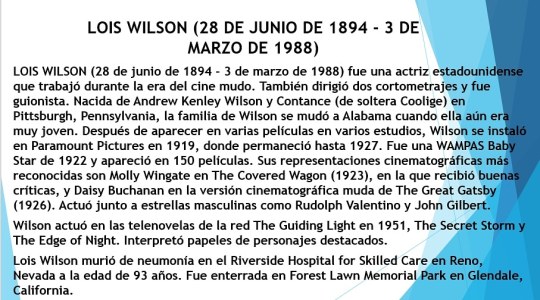

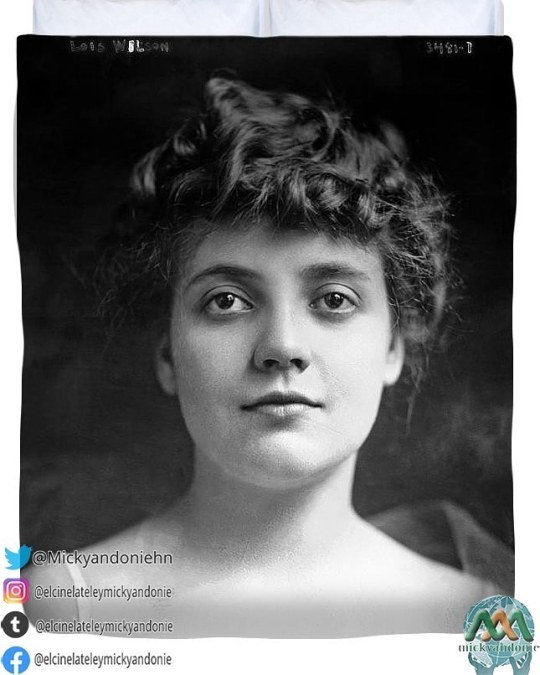

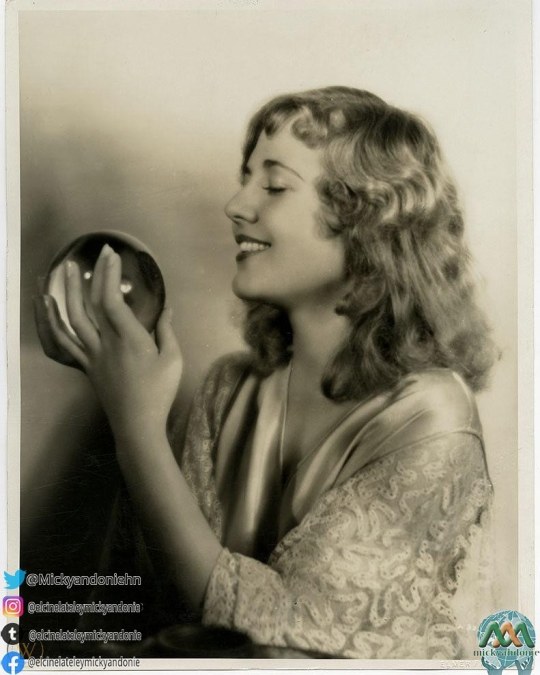
LOIS WILSON.
Filmography
1915 The Palace of Dust
1915 The New Adventures of Terence O'Rourke
1915 When a Queen Loved O'Rourke
1915 The way to paradise
1915 The Hypocrite
1916 The Langdon Legacy
1916 The Silly Girl from Portici
1916 Married on the wing
1918 A man of a man
1919 The Tramps
1919 Come Again Smith
1919 the end of the game
1919 Brass doors
1919 The Godfather
1922 Broad Daylight
1923 The covered wagon
1923 Bella Donna
1923 Solo 38
1923 The Man of a Man
1923 To the Last Man
1923 Red Gap Ruggles
1925 The Thunder Pack
1925 Welcome home
1925 marry me
1925 Rough water
1925 The Vanishing American
1925 The King on Main Street
1925 Irish Luck
1925 Seven Wives of Bluebeard
1926 Let's get married
1926 Fascinating youth
1928 Ransom
1928 Sally's shoulders.
Créditos: Tomado de Wikipedia
https://en.wikipedia.org/wiki/Lois_Wilson_(actress)
0 notes
Text
The 1919 Boston Molasses Flood: The Forgotten Tragedy too Bizarre For the History Books
A 30-foot wave of molasses killed 21 people and injured 150 others.
— John Platt | November 28, 2016,

An 8-foot wave of the syrupy brown liquid moved down Commercial Street on a January morning at a speed of 35 mph. Wreckage of the collapsed tank visible can be seen in background.
The 21 people who died in Boston on Jan. 15, 1919, had little warning of the events that were about to occur. According to an article published the next day in The New York Times, the only sound before the disaster was "a dull, muffled roar." That was the noise made by the explosion of a massive tank of molasses owned by the Purity Distilling Company. Moments later, more than 2 million gallons of hot, thick, sticky molasses flooded the surrounding streets, destroying buildings, overturning wagons and trucks, and even knocking an elevated train off its tracks. Witnesses say the wave of molasses reached as high as 30 feet tall and it traveled as fast as 35 miles per hour.
For the people in the surrounding streets and buildings, there was no escape. Twenty-one people died, including three firemen who were killed when their nearby firehouse collapsed. Another 150 people were injured, and several horses were also killed. Police, a local Army battalion, the Red Cross and even the Navy arrived to help the survivors, but rescuers were hampered by the sticky goo that filled the streets. It took four days to find all of the victims, and another two weeks to clean up the molasses mess. Even today, nearly a century later, some people say the neighborhood still smells like molasses on hot summer days.
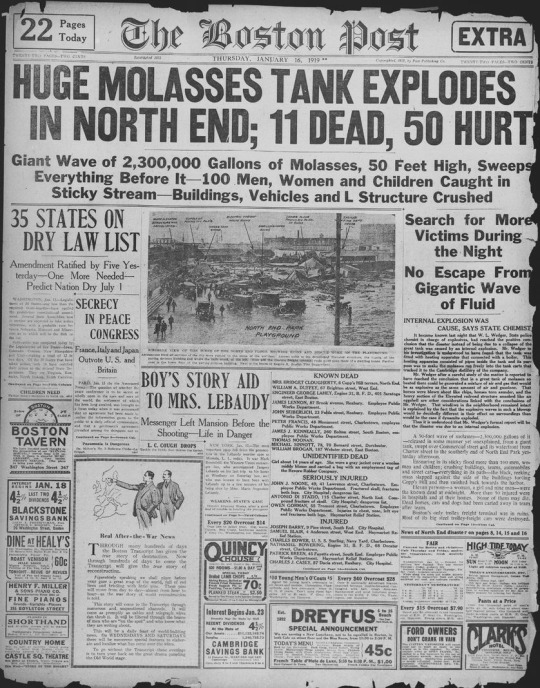
Coverage of the Great Molasses Flood in the Boston Post.
This terrible event has come to be known as the Great Boston Molasses Disaster, one of the most bizarre — and least talked about — tragedies in U.S. history. As Stephen Puleo writes in his excellent book, "Dark Tide: The Great Boston Molasses Flood of 1919," it's possible that the history books rarely take notice of the tragedy because no one "prominent" died that day. "The survivors did not go on to become famous," Puleo writes. "They were mostly immigrants and city workers who returned to their workaday lives, recovered from injuries, and provided for their families."
Why Did It Turn into a disaster?
So what caused the flood? Purity immediately placed the blame on anarchists, saying the explosion that ripped open the molasses storage tank must have been sabotage. Years of hearings and testimony by hundreds of people revealed otherwise: the tank wasn't built well and it was poorly maintained. It appears that the fermentation process combined with an abnormally warm day caused a buildup of pressure within the tank, more pressure than the roof and walls could contain. The unseasonably warm weather — 41 degrees, up from just 2 degrees that morning — may have also contributed to the high death toll, since more people were on the streets than would have been normal for Boston in January.
More recently, scientists have been digging into the story, looking for clues. Nicole Sharp, an aerospace engineer who runs a popular Tumblr blog, and Jordan Kennedy of Harvard University gathered data from historical records and studied how molasses flows under various conditions, according to New Scientist. They wanted to know if fluid dynamics could help solve the mystery — and they were right.
The true culprit: gravity currents, which come into play when a dense fluid spreads horizontally into a less dense fluid (in this case, molasses into air). It’s similar to how dense cold air will flow through an open door into a warm room, even if there is no wind to drive it. The density of the molasses alone would account for the speed of its initial spread. “Basically, you got bowled over by a tidal wave of molasses,” says Sharp, likening the effect to a sticky-sweet tsunami made of a substance 1.5 times as dense and several thousand times more viscous than water.
Ultimately Purity and its parent company were found to be responsible. The civil lawsuit lasted until 1925. That year the company took a charge of $628,000 against its profits, reflecting settlements and legal costs related to the disaster. That's about $8.3 million in 2013 dollars.
In his book, Puleo points out that the flood — though mostly forgotten today — embodies life in United States during the early 20th century. The tank was built during World War I. Prohibition arrived the following year. The labor movement was growing, dangerous anarchists were active, and the country was dealing with issues related to immigration. "The flood, therefore, was a microcosm of America, a dramatic event that encapsulated something much bigger," he writes, calling it "a lens through which to view the major events that shaped a nation."
This story was originally published in June 2013 and has been updated with more recent information.
— Mother Nature Network
0 notes
Link
7 Hidden Secrets discovered about Michigan’s Sleeper State Park
Sleeper State Park Michigan was the first state park in the Thumb. It has been a place to visit for over 95 years with an excellent beach and modern campsites. Named for Michigan Governor and local businessman Albert E. Sleeper, the park is one of two state parks in the Upper Thumb. It’s one of the most widely viited parks in Southeast Michigan. The park contains impressive secrets in what is available for the veteran visitor.
#1 Sleeper State Park Is Bigger Than The Beach And Campground
Driving by the park, visitors immediately see the day-use picnic and beach area along the shoreline and the extensive 226 site campground across M-25 from the beach. That is a small slice of the park. Sleeper State Park has over 700 acres of wetlands, an ancient dune forest, a half mile of beautiful sandy beach and natural dunes guarding the shore.
Sleeper State Park Beach Access Stairs to the Beach Protect Fragile Dunes Families and groups can spend the day swimming, kayaking, and playing at the beach.
A large covered pavilion is available for rent steps away from the beach. It’s perfect if you have a large group, such as a family reunion. The beach area is known as an ideal spot for beach weddings and company picnics.
#2 Sleeper State Park Was Named For A Local Leader Who Became Governor
In 1925, the woods, dunes, and beach we see today opened as a county park. By 1927, the State of Michigan acquired the property and called it Huron State Park. In 1944, a group of Huron County citizens petitioned the state to rename the Park. The park was renamed in honor of Albert E. Sleeper, a resident and business leader in the Thumb region.
Albert E. Sleeper - Sleeper State Park, Sleeper was governor of Michigan from 1917 until 1920.
#3 You Can Camp In Relative Luxury Away From Everything Else
Sleeper State Park has arranged with a camping outfitter that offers people a more private and comfortable camping experience. It’s called “glamping”. Glamping is a concept where nature meets a bit of spacious luxury. A fusion of the words glamour and camping or “glamping” is a way to authentically experience a bit of remote rustic camping in unique locations.
The glamping experience is new to Michigan’s Albert E. Sleeper State Park and Highland Recreation Area starting the summer of 2020. More information about the Sleeper-Safari Tent program is on their website.
#4 There Are Mountain Bike Trails In Sleeper State Park
Sleeper State Park Map Showing Trails
Sleeper State Park Trail Map
One of the parks’ best-kept secrets is the extensive trail system located just south of the campground. Over four miles of marked trails are available for. hiking, cross country skiing, (Which is groomed in the winter), and mountain biking.
#5 You Can Try Kayaking At Sleeper State Park Beach
Turnip Rock what to Bring Saginaw Bay is known for its sea kayaking areas. Explore the islands and inlets of Wild Fowl Bay or paddle along the sugar sand shoreline. Just a bit further north in Port Austin is two well-known Kayaker destinations of Turnip Rock and Broken Rocks. Sleeper State Park beach is also a stop on the 100-mile Tip of the Thumb Heritage Water Trail. The beach at Sleeper State Park is a perfect place to try out kayaking for the first time or to show others how it’s done. Kayaks are available for rent at the beach.
#6 There Are Archaeological Significant Sites In The Park
In a Stewardship report made in 1995 by the Michigan DNR, it noted that the potential exists for prehistoric sites in the park. Similar land formations have proven in the nearby Rush Lake State Game Area, where 36 sites have been recorded. These include prehistoric sites, as well as nineteenth and twentieth-century historic sites. Three more sites exist west of the park. One of these was found to be a large multi-component site. Its thought that smaller sites related to this large site are located in Sleeper State Park.
#7 You Can Buy A Latte Or Smoothie At The Sleeper Campground
Sleeper State Park Chuck Wagon
The Chuck Wagon at Sleeper State Park
If you get a hankering for a Latte or Frappuccino when you’re camping you’re in luck. We found the “Chuck Wagon” waiting for us in the Albert E. Sleeper State Park campground area. It’s an open-air bar with seating for 12 people. They offer coffee, frappe, and smoothies. This is a mobile food truck part of Chucks Drive-Thru Diner in Caseville State Park . This mobile bar may move on from time to time especially during the Cheeseburger Festival.
0 notes
Text
VIRGINIA
24 Nov 2019 (Sun) – We went to the American Civil War Museum and Tredegar Iron Works. It turned out we had been to the iron works before. They were closed today so we could not revisit them. The Civil War Museum was recently built and we toured that. The museum was done tastefully. They told the story of the Civil War objectively, not emphasizing any side over the other. There was a special display on the second floor about money. It covered the purpose of money and showed the different types of currency used during the Civil War. It was quite interesting.

We then drove around looking for a place to eat. The first place we stopped had loads of closed up shops. We decided to move on. We drove to another part of town and ate at the Fancy Biscuit. It was a small, crowded place. The food was good.
After lunch, we drove to the Maymont Estate. James & Sally Dooley built the mansion in 1893 and lived in it until 1925. Upon their deaths, the grounds with its 32 buildings were left to the City and designated as a museum. The Dooley’s bequeathed $3 million to the local hospital. At the time, it was single largest charitable contribution in the history of the United States (valued at $42 million in today’s dollars).

23 Nov 2019 (Sat) – We drove into Richmond today. First stop was at the White House of the Confederacy. President Jefferson Davis lived in the house with his family during the four years of the Civil War. He was the only president of the Confederate States. Davis was married twice. His first wife died of malaria. His second wife, Varina, was 18 to his 36 years. He took her to see the grave of his first wife on their honeymoon (romantic cuss, huh?). The house was a lovely southern home, decorated tastefully and eloquently. It fell into disrepair after the war and was slated to be torn down. A ladies historical club stepped forward to save the building and the home was turned into a museum in 1898. It’s been a museum ever since.
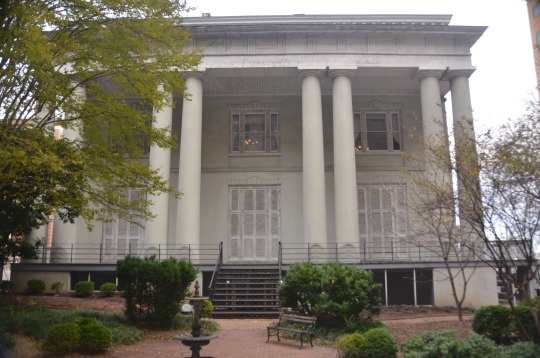
Our next stop was at The Capitol Building. It was done in the classic Greek style or southern style. They expanded the capitol two years ago by building an additional area underground. We took a tour of four floors. It was a beautiful building with lots of history. It was humbling to know that we were walking the same halls frequented by our early forefathers.

After the capitol tour, we walked several blocks to Sam Miller’s Restaurant for lunch. It was a historical building that had been updated. The food was good. We returned to the campground to find we are still the only campers here.
22 Nov 2019 (Fri) – We pulled up stakes and headed out to Richmond this morning. It rained most of the way and traffic was brutal. The slow crawl took us over six hours to get to the DLA Supply Center Richmond Family RV Rec Area. The “campground” only has six sites in an area right off the main roadway. The first spot we pulled into had problems with the electric so we moved to another pull through site.

After set up, we drove to a nearby theater and saw “Midway.” It was an interesting movie but had a little too much CGI for our taste. I am always amused with any movie about WWII where the Japanese General, Yamamoto, says “I am afraid that we have awakened a sleeping giant and filled him with a terrible resolve.” No matter what the scene, the general makes the same exact statement.
We stopped at a Jersey Mike’s Sub shop. It is like a Subway. You go in, either pick out premade sandwiches or pick out what you want on a sandwich. It was OK but nothing special.
21 Nov 2019 (Thu) – We drove to Occoquan this morning. This was a delightful historical town we stumbled upon years ago and try to visit again whenever we are in the area. We enjoyed lunch in the Secret Garden Café, an out-of-the-way eatery that we almost missed because the entrance was up a set of stairs between stores. While in town, we stopped by the visitor center to get some information to share with fellow campers next year when we have a SMART muster on Fort Belvoir.
Next stop was at Manassas National Battlefield. It was quite interesting. The story is that the civil war started and ended there. The first major battle (The First Battle of Manassas) of the civil war was fought on the grounds of the Henry family. Many soldiers died on either side as well as the woman who owned the farm. At the end of the war, Robert E. Lee signed the papers of surrender in that same farmhouse.
After the museum, we went for a late lunch at the City Grille. Someone recommended it as a local delight. It was OK but certainly not anything special.
20 Nov 2019 (Wed) – We left New York yesterday and spent the night at Aberdeen Proving Grounds in Maryland. That drive was six and a half hours! It took us two and half hours just to get off Long Island. Ugh. We arrived at Aberdeen at dusk. We hurriedly set up as it is harder in the dark. We got it done in time.
It was a very nice campground with spacious sites and concrete pads with full hookups. The campground is right on the water so we took a walk down by the shore. There was evidence that it had overflowed very recently.
We left MD at 9:35 and arrived at Fort Belvoir, VA, at noon. This is also a very nice campground with spacious sites, concrete pads, and full hookups with the Potomac River right next to the campground. We went to Outdoor Recreation to check in and make reservations for next year’s caravan. Unfortunately, there is some confusion about the caravan so we had to call the Wagon Master. After calls back and forth, it got sorted out and we made reservations for both us and our friends, Brenda & Rick.
After set up, we drove to the commissary to get some groceries then to the MWR Office of Travel & Leisure Services where we bought tickets for Walt Disney World. We are so excited! We will be there in January.
1 note
·
View note
Link

Although Homes are typically designed to be a safe haven, sometimes they're made with less positive intentions.
"Spite houses" are homes that were built to irritate neighbors or serve as an act of revenge.
They're a common phenomenon throughout the world, often becoming tourist destinations once the original owners no longer own them.
A house painted to look like candy canes and a tiny home built just to block a brother's view are only a couple of the spite houses that exist.
Visit Insider's homepage for more stories.
FOLLOW US: Insider is on Facebook
Despite the importance of loving thy neighbor, fights between those who live near each other are common, and can even result in what is known as a spite house.

A spite house is one that is built with the sole intention of irritating a neighbor or as an act of revenge against another landowner.
They're a common phenomenon, and you can find them all over the world.
For instance, a London resident painted this house red and white after her neighbors prevented her from demolishing it.
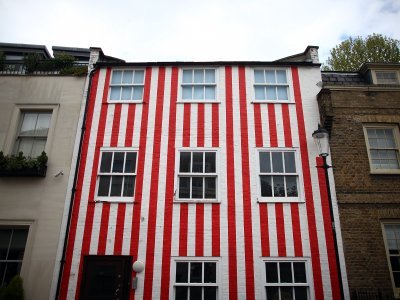
In 2015, Zipporah Lisle-Mainwaring wanted to demolish her London home, but when her neighbors objected to the plan, she decided to paint it with candy cane stripes instead, according to The Guardian.
Although her neighbors attempted to force her to repaint, the High Court in London ruled that she could ignore a planning order from the local council in 2017.
She was also given permission to move forward with the demolition in 2017, according to the Evening Standard.
It's believed that the Skinny House in Boston was the result of a feud between brothers.
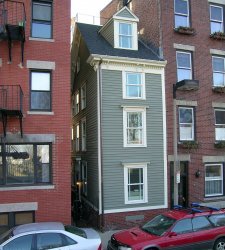
According to Boston Magazine, The Skinny House is believed to have been built after a man returned from serving in the Civil War only to find that his brother had built a large house on their shared land.
The 1,166-square-foot building blocks the adjoining home's view of the Boston harbor, as well as its access to sunlight.
The Equality House sits directly across from Westboro Baptist Church in an act of protest.

The Equality House, located in Topeka, Kansas, is the resource center for Planting Peace, a global non-profit organization.
Planting Peace bought the house in 2013, according to the Huffington Post, with the intention of making a statement against Westboro Baptist Church, whose members are known for picketing the funerals of fallen soldiers.
The Equality House still stands today, and Planting Peace added a second home called the Mott House in 2016, which is painted the colors of the transgender flag.
The Spite House in Alexandria, Virginia, was built in a former alley.
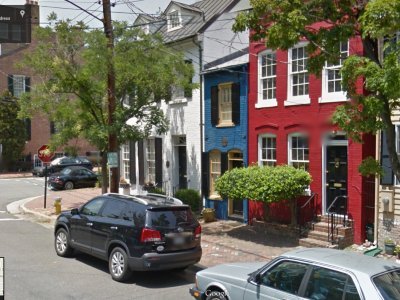
At just seven feet wide, the Spite House has been dubbed the narrowest house in America. The 325-square-foot house was built in 1830 by John Hollensbury, who lived in one of the adjacent homes, as reported by The New York Times.
Hollensbury built the tiny home to prevent horse-drawn carriages and passersby from moving through the alley. From inside, you can see marks on the brick walls from wagon-wheel hubs.
The Montlake Spite House came to be after the land parcel's owner was insulted by a neighbor's offer to buy it.

The Montlake Spite House in Seattle, Washington, was built in 1925. As legend has it, the owner of the 3,090-square-foot parcel of land was offered a small amount of money from his neighbor who hoped to turn the plot into a garden.
According to Atlas Obscura, the landowner was offended by the small offer and decided to build a small house instead.
In 2016, the spite house, which is only 15 feet wide, hit the market for more than $519,000.
Dr. John Tyler built this Maryland home to defy his town's city hall.
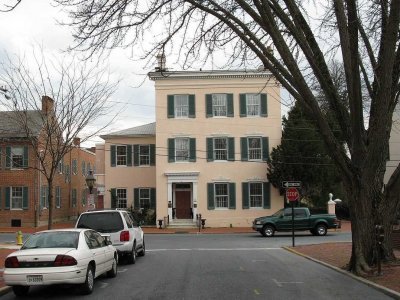
Located in Frederick, Maryland, the Tyler-Spite House was built by Dr. John Tyler in 1814. According to local lore, the spite home was built after Tyler discovered that the city planned to build a road through his property.
Tyler found a law that said the road couldn't be built onto the property if a building already existed, or was in the process of being built on it, so he tracked down a contractor who was willing to start construction the night before the road was set to be paved.
Because of Tyler's dead-of-night construction, the road couldn't be paved, and the home he built is still called the Frederick-Tyler Spite House today.
Historians claim the Spite Tower in Adamsville, Rhode Island, was built in response to a neighborly spat.

Local Rhode Island historians claim the Spite Tower was built in 1905 after two neighbors had a fight and one of the men wanted to block the other's view of the town.
But, according to Herald News, the house may have just been built in its location because it sits over a well. The height would have been necessary for accessing the water.
Regardless of its origins, the name stuck, and the Spite Tower is still a popular tourist destination today.
This house in Freeport, New York, was built to stop the city from being designed as a grid system.

Known as both the Freeport Spite House and the Miracle House, developer John Randall built this Victorian-era home at the turn of the 19th century.
Randall reportedly built the two-story house to prevent the city from being laid out in a grid. The structure, which still stands today, was placed on a triangular plot of land.
The Plum Island Pink House has its origins in a marriage that ended poorly.

The Plum House, located in Newbury, Massachusetts, was built in the 1920s as a replica of a couple's former family home, according to Atlas Obscura.
The legend states that a woman's soon-to-be ex-husband had to build a replica of the house as part of their divorce agreement, but the court didn't specify where the house had to sit.
To spite his former spouse, the man built the house on top of a salt marsh and used saltwater for the plumbing, making it uninhabitable.
The Edith Macefield House has been compared to the floating house from Disney's "Up" after the owner refused to vacate her property to make way for a developer.

In 2006, Edith Macefield was reportedly offered $1 million to sell her Seattle, Washington, home to a developer that wanted to turn the lot into an office building.
The property was built around her house, inspiring comparisons to Carl Frederickson's home in "Up." Passersby even hang balloons on the fence outside of the house as a nod to the Disney film.
The house remained on the property even after Macefield's death in 2009, as she bequeathed it to the construction superintendent for the project, as reported by Seattle PI.
Read more:
15 obnoxious houses that were built just to annoy the neighbors
A woman is accused of leaving a $5,000 'revenge tip' on a $60 check with her boyfriend's credit card
8 of the ugliest, most hated buildings in the world
Disappointing photos show that tiny homes may not be everything they're cracked up to be
from Design http://bit.ly/2qGxJ8A
0 notes
Text
“America’s Most Famous Dessert”

Recipe Booklet, “Joys of Jell-O,” circa 1962 THF294490
As Project Curator for the William Davidson Foundation Initiative for Entrepreneurship, I research objects within The Henry Ford’s collections that tell entrepreneurial stories. Most recently, I delved into the Recipe Booklet Collection, which includes recipe booklets and pamphlets from 1852-2006. In researching the many companies represented within the collection I became intrigued by the recipe booklets, and the entrepreneurial story, of the much beloved dessert: Jell-O.

Colorful drawings in the recipe booklet, “Jell-O, America’s Most Famous Dessert,” 1916 THF294400
For more than a century, Jell-O has been served at family gatherings, pot-lucks, and barbeques, becoming an American icon.
Jell-O is made with two primary ingredients: sugar and gelatin. Gelatin is made by extracting collagen from boiled animal bones, hooves, and tissue. Known for its binding capabilities, gelatin has been used as a recipe ingredient for centuries, particularly for molded desserts. Originally, gelatin dishes were most common in wealthy households where servants could be tasked with the time-consuming and unsavory work of making gelatin.
Gelatin is odorless and flavorless, always an added ingredient to a recipe and never a stand-alone dish. Advances in gelatin production eventually led to its packaged powdered form – an innovation that erased the time-consuming preparation and made the product available to nearly everyone. Still, sugar and spices had to be added by the maker. In 1897, Pearle Wait, a carpenter and patent medicine producer, combined fruit flavoring and sugar with gelatin powder to create a pre-packaged fruit-flavored dessert that just required boiling water and some time to cool and set. Pearle Wait and his wife, May, were amazed by the delicious result and the couple believed it would thrive in the packaged food business. May is attributed with having given the Jell-O name to the new product.

Insert within the recipe booklet, “Jell-O Ice Cream Powder: Doesn’t That Look Good?” circa 1910 THF294409
The name “Jell-O” followed a trend at the time of adding an “O” to the end of product names.
With a catchy name and what he thought was a product full of potential, Pearle Wait attempted to sell his new product door-to-door. Unfortunately, Wait lacked the resources necessary to market his innovation, let alone hire salesmen. Less than two years after creating Jell-O, Wait sold the rights to the product and name to a fellow patent medicine competitor, Orator F. Woodward, for $450.
As owner of the Genesee Pure Food Company, Woodward had already experienced success with his health drink, Grain-O. After acquiring the rights to Jell-O, Woodward quickly created advertising for the promising product, but he too struggled to make a profit. He was so frustrated by his lack of initial success that he offered the Jell-O rights to one of his employees for $35. The man refused, which turned out to be extremely fortunate for Woodward. By 1902, his struggling Jell-O business had become a quarter-million-dollar success.
Some believe that this slow start was due to the fact that homemakers prided themselves on their homemaking skills. Ready-made products, such as Jell-O, were looked down upon as too simplistic, requiring no skill. Ironically, the product owed its success to recipe booklets, which provided creative uses for this ready-made product. As early as 1902, booklets were distributed by finely dressed salesmen who went door-to-door on distinctive wagons drawn by well-groomed horses. Once every household in a given area had a recipe booklet, a salesman would go to the local grocer and advise him to stock Jell-O to meet the impending demand. The recipe booklets were a huge success. Jell-O became a household name as homemakers across the country marveled at the “magic” dessert that could be transformed into a colorful dish for any occasion.

Page from the recipe booklet, “Jell-O, America’s Most Famous Dessert,” 1916 THF294401
Jell-O booklets included recipes for a variety of desserts. Some recipes called for additional ingredients of whipped cream, or fresh or canned fruit, while others suggested homemakers use a gelatin mold or specialty serving dishes for a beautiful, sophisticated presentation.
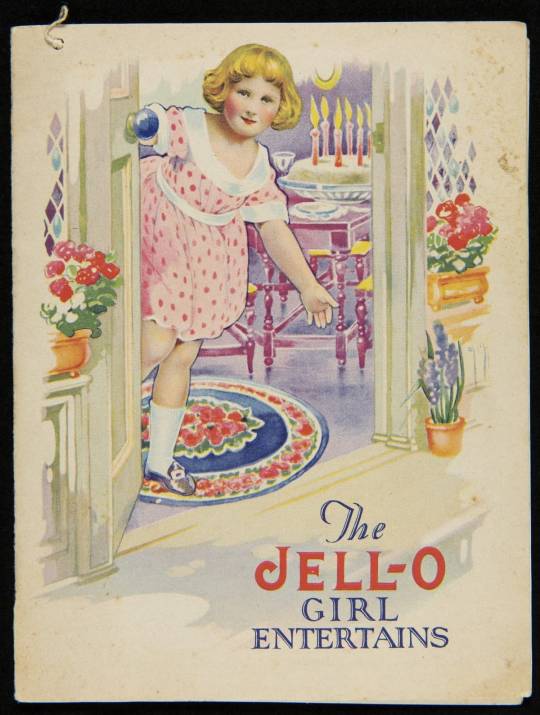
Recipe Booklet, “The Jell-O Girl Entertains,” circa 1930 THF294510
Jell-O introduced one of its most successful marketing strategies, the Jell-O Girl, in 1904. She helped reinforce the idea that children loved Jell-O and proved that it was easy to make – so easy a child could do it. In this booklet, the Jell-O Girl tells readers that she’s hosting a party and wants to serve her favorite dessert, Jell-O. The booklet includes the Jell-O Girl’s favorite party recipes and describes tips every hostess should know.

Back cover for the recipe booklet, “Polly Put the Kettle On We’ll All Make Jell-O,” 1924 THF294438
Heavy advertising contributed to Jell-O’s success. For some marketing campaigns, Jell-O enlisted prominent artists, including Norman Rockwell and Maxfield Parrish, who designed the image featured here.

Page from recipe booklet, “Jell-O Secrets for the Automatic Refrigerator,” 1929 THF294522
Although Jell-O became known as “America’s Most Famous Dessert,” it was also suggested as an ingredient in appetizers, molded vegetable salads, and entrées.

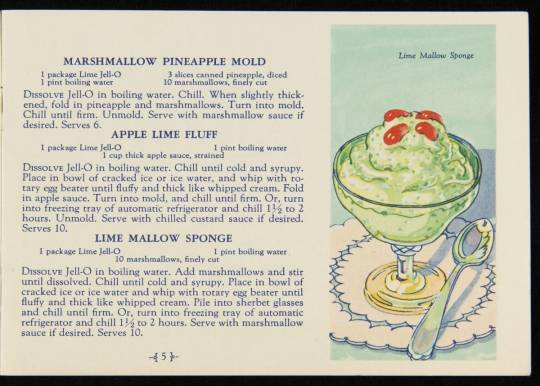
Cover and page from the recipe booklet, “New Jell-O Recipes Made with the New Flavor Lime,” Circa 1930 THF294532
In 1897, Jell-O was sold in four flavors: Strawberry, Raspberry, Orange, and Lemon. By 1906, the Genesee Pure Food Company introduced Cherry and Chocolate, with Peach following soon after. Lime Jell-O debuted in 1930.
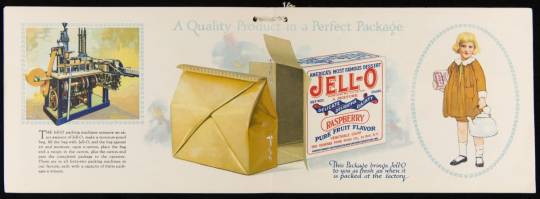
Page from the recipe booklet, “Polly Put the Kettle On We’ll All Make Jell-O,” 1924 THF294430. Jell-O became a sensation, with factories producing over 1,200 packages per minute by 1924.
By 1923, Jell-O sales had far surpassed the Genesee Pure Food Company’s other ventures, prompting the company to formally change its name to the Jell-O Company. Two years later, in 1925, the Jell-O Company Inc., was sold to Postum Cereal Company, Inc., which would later become part of the large conglomerate General Foods Corporation.
Samantha Johnson is Project Curator for the William Davidson Foundation Initiative for Entrepreneurship at The Henry Ford. Her favorite Jell-O recipe is for what her mother calls “Raspberry Fluff,” made with cottage cheese, Cool Whip, and a dry Raspberry Jell-O package.
#1 Ford Daily | Đại lý – Showroom ủy quyền Ford Việt Nam 2019 Ford Daily là showroom, đại lý Ford lớn nhất Việt Nam: Chuyên phân phối xe ô tô FORD như: EcoSport ✅ Everest ✅ Explorer ✅ Focus ✅ Ranger… [email protected] 6A Đường Trần Hưng Đạo, Phường Phạm Ngũ Lão, Quận 1, Hồ Chí Minh 711240 0901333373 https://forddaily.com/ https://forddaily.com/xe/ https://forddaily.com/dai-ly/ https://forddaily.com/bang-gia/ https://forddaily.com/tra-gop/ #forddaily #dailyfordhcm #fordshowroomhcm https://www.google.com/maps/place/Ford+Daily/@10.7693359,106.696211,15z/data=!4m5!3m4!1s0x0:0x1f188a05d927f4ff!8m2!3d10.7693359!4d106.696211
0 notes
Text
Wesley Chapel's History & Presence
Wesley Chapel is an unincorporated census-designated place
of 6.1 square miles at the southern border of Pasco County near I-75 and I-275.
In 2010, the US Census recorded 44,092 residents. It is one of the fastest
growing areas in the United States

John Boyette was born in 1875, the son of John “Berry” Boyette and nephew of Thomas Ashley Boyette. He is shown with his wife Blanche, and children, Johnnie, William, Ruby, and Vera. Photo courtesy of Cletia Pierce, from Images of America: Wesley Chapel by Madonna Jervis Wise. (e2679)
The pioneer Boyett(e), Gillett(e), Godwin, and Kersey
families received land grants in the area in the 1840s. The real influx of
settlers, however, began around the War Between the States when the Stanleys
and Coopers arrived.
A historical marker has: “Originally called Double Branch for the twin creeks that flowed across the Boyette land, the community was named for the Methodist chapel that stood on the northwest corner of SR 54 and Boyette Road.”
The church itself was named for John Wesley, the founder of the Methodist movement. The name “Wesley Chapel” appears in Hernando County school board records from 1877-1878. At this time, Pasco and Citrus Counties were united as part of Hernando County.
Previous Names for Wesley Chapel

Alligator hunting in the swamps of Wesley Chapel. Lonnie Tucker on far left is guiding the two visitors through the swamp. Photo courtesy of his daughter Anna Jo Bracknell, who said it was typical for him to harvest 3 to 4 gators per evening. From Images of America: Wesley Chapel, by Madonna Jervis Wise. (e2656)
A popular nickname for the area at that time was Gatorville. It was not because of University of Florida either.
In September of 1887 voting precincts were established for
the newly-formed Pasco County. Wesley Chapel was designated Precinct 4.
A post office operated in the area from 1897 to 1902. The post office was called “Wesley,” and maps during that period have the shortened name “Wesley” and some school board minutes also used the shortened name.
Since its founding in 1878, the Double Branch Baptist Church (now the First Baptist Church) has served as a focus for Wesley Chapel community life. The church has had three buildings in its long history. Henry Ryals was pastor in the first building in 1880, Ed Bryant the second in 1935, and Lynn Foster the third in 1970.
Early Wesley Chapel Industries
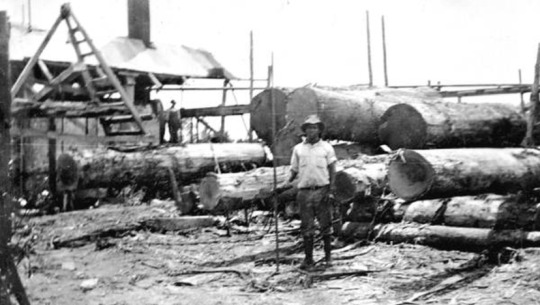
Cuts Manning, a log roller at the sawmill. (Florida State Archives)
The turpentine still and sawmill represented early industries, though cattle ranching and hog farming on the then open range, crop farming, and citrus growing predominated. When times were hard people turned to charcoal making and even moonshining to survive.
Most roads began as wagon tracks between the farms and ranches and the locations where goods were sold. Eventually these were improved, paved and today have names like State Road 54!

Born on July 25, 1876 in Quitman, Georgia. Moved to Pasco County as a young man and married Ellen Osburn. Agent Waters was shot and killed along with Pasco County Deputy Sheriff Arthur F. Crenshaw from ambush on October 4, 1922. They were returning from a ranch after completing the execution of a search warrant for bootleg liquor. The name of John V. Waters is inscribed (East Wall, Panel 27, Line 5) on the National Law Enforcement Memorial in Washington, D.C. (State of Florida Archives)
In 1925, there were 3 incidences of arrests, deaths and illegal moonshine production in Wesley Chapel reported in the Tampa and Dade City newspapers. The moonshine operations continued through 1927, with Federal Marshalls uncovering numerous stills and confiscating thousands of gallons of liquor and mash.
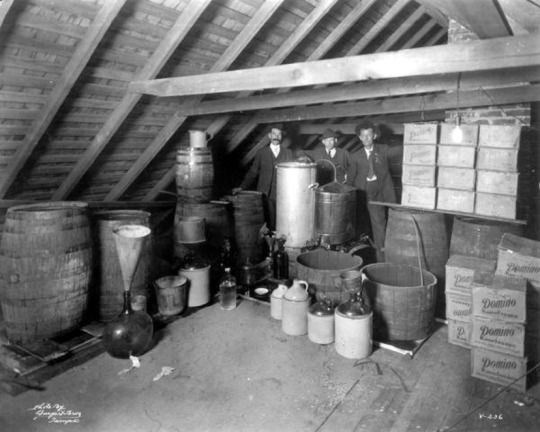
Moonshine and a still in the attic. (Florida State Archives)
A prominent local name, Strickland, and a Sicilian distiller named Sangiorgi were some of the many people whose copper stills, liquor, weapons, and mash were confiscated from the local swamps and deep woods during Prohibition.
Wesley Chapel begins Growth with Electricity in the 1940s
Luther Daniel Smith was instrumental in bringing electricity
to the community of Wesley Chapel in 1940s while he served on the Withlacoochee
River Electric Cooperative Board.
In 1956, the Highway 54 West Bridge was built west of the
Eagles Flea Market. The 1960s saw the construction of I-75, connecting the area
with travelers from the north and south.

Double Branch Baptist Church Groundbreaking. Photo provided by Madonna Jervis Wise, author of Images of America: Wesley Chapel. (e2651)
In 1971, a new sanctuary was built for the Double Branch
Baptist Church and the former one was torn down.
The Wesley Chapel pioneer cracker home of Daniel Smith, built in 1894, was donated to Cracker Country in 1979. This hands-on museum is housed at the Florida State Fairgrounds, Smith House, and shares the story of frontier life in Wesley Chapel.

Saddlebrook Resort post card, about 1982.
Saddlebrook Resort formally opened in 1981, with a car-free walking
village design, allowing guests to walk throughout the resort without the need
of a transportation system while providing sanctuary to nature. Thomas L. Dempsey
was the visionary for this award-winning golf and tennis resort in Wesley
Chapel.
Wesley Chapel's Education and Housing

Wesley Chapel School (1926-27) The two-room schoolhouse was located where the current parking lot of the current First Baptist Church of Wesley Chapel (off SR 54) now is situated. It would be the parking lot to the left of the church if you are facing the front of the church. One room was designated for the 1st through 4th grades and the second room was for the 5th through 8th grades. Photo courtesy of Wayne Sweat, from the new book "Images of America - Wesley Chapel" by Madonna Jervis Wise. (e839)
Wesley Chapel began growing at an unprecedented rate about
this time. 1998 saw the construction of the Sand Pines Elementary School, the
community’s first modern school. Today there are eight public elementary
schools in Wesley Chapel, as well as two middle schools and two high schools.
In fact, the Double Branch Baptist Church was renamed the First Baptist Church
in 1999, the same year as Wesley Chapel High School opened.
In 2006, Wiregrass Ranch High School opened to meet the growing demand of families moving to Wesley Chapel. There are many housing and apartment complexes that were built on the ranches and farms of yesteryear.

Epperson Ranch opened with the Crystal Lagoon in Wesley Chapel.
In 2018, Epperson Ranch opened the Crystal Lagoon, the first
man-made clear water lagoon in the U. S. This 7.5 acre freshwater lagoon is
available to both residents of the Epperson Ranch and the public.
Wesley Chapel's Shopping and Dining
The first outdoor mall to be built in the area is The Grove,
a 445,000 square foot complex that includes a Cinebistro movie and dining
theater. The Grove is located in the northeast quadrant of I-75 ad State Road
54.

Enjoy dining served at the movie theater at the Cobb Theater in The Grove shopping center.
One of those is Wiregrass Ranch, a 5,000-acre ranch that was owned by the Porter Family. In 2008, The Shops of Wiregrass, an open-air retail and entertainment destination located on the corner of State Road 56 and Bruce B. Downs Boulevard, opened there.

The Shops of Wiregrass is a popular Wesley Chapel shopping and dining destination.
Florida Hospital Wesley Chapel opened a $150-million hospital
and wellness center on part of the land in 2012.
In 2015, the Tampa Premium Outlets shopping mall brought
discount designer retail to the area and continued the wave of development to
the west side of I-75/I-275.
The abundance of state-of-the-art retailers, restaurants and
amenities have caught the eye of people from around the world who seem to be
moving to Wesley Chapel in droves.
Wesley Chapel's Sports Tradition Continues

The largest hockey complex in the southeast U.S., premiere golf and tennis academies and more make Wesley Chapel a great place to grow your sports skills!
The largest hockey complex in the southeast United States is
in Wesley Chapel. Advent Health Center Ice was opened at I-275 and State Road
56 in 2017. It has four full-sized ice rinks, as well as a kid-sized rink and
offers classes in figure skating, hockey, curling as well as tournaments, open
skates and dry rink activities. Rentals and events are available.
Saddlebrook has continued its tradition of tennis and golf education, opening the Saddlebrook Preparatory Academy to provide an accredited comprehensive education program while they are attending the Saddlebrook Tennis Program or Golf Academy
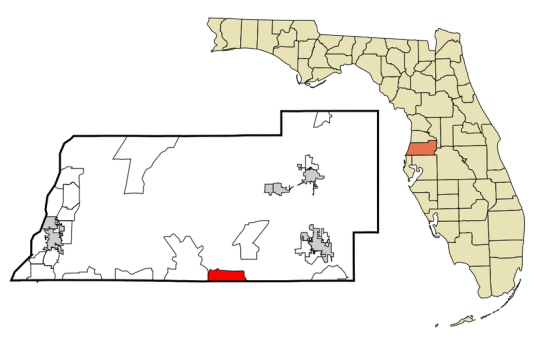
Wesley Chapel is an unincorporated area at the southern border of Pasco County, approximately midway between the east and west borders. It is a unique part of Florida's Nature Coast. Arkyan
Is Wesley Chapel part of the Nature Coast?
Wesley Chapel continues to grow in population and amenities.
In an area that was pre-designated for economic growth and development, the
Connected City is focused on the next-generation experience of its residents.
This is not simply rooftops, streets and commerce, this is Smart Homes,
autonomous vehicle paths and a business core designed to attract and support
the best and brightest, according to Pasco County.
And, though Wesley Chapel seems more like a bedroom community of Tampa, its location within Pasco County makes it part of Florida’s Nature Coast. There is certainly a lot of shiny new stuff there along with a history that is common to the rest of our area.

Wesley Chapel is one of the fastest growing areas of Florida with tons of options and amenities. Image courtesy of Pixabay
My eldest son chose to live in Wesley Chapel, even though he
was raised in Brooksville. As a young man, it was more appealing to him to live
in a multi-story apartment complex with twenty chain restaurants that will
deliver to him at any time. He still loves to come out and kayak, fish and walk
in the woods. He would rather drive to the outdoor recreation. I would rather drive
to the shopping and restaurants.
Florida’s Nature Coast has it all and Wesley Chapel is an important
part of that.
Read the full article
0 notes
Photo

"I have the nerve to walk my own way, however hard, in my search for reality, rather than climb upon the rattling wagon of wishful illusions."
- Letter from Zora Neale Hurston to Countee Cullen
Zora Neale Hurston knew how to make an entrance. On May 1, 1925, at a literary awards dinner sponsored by Opportunity magazine, the earthy Harlem newcomer turned heads and raised eyebrows as she claimed four awards: a second-place fiction prize for her short story "Spunk," a second-place award in drama for her play Color Struck, and two honorable mentions.
The names of the writers who beat out Hurston for first place that night would soon be forgotten. But the name of the second-place winner buzzed on tongues all night, and for days and years to come. Lest anyone forget her, Hurston made a wholly memorable entrance at a party following the awards dinner. She strode into the room--jammed with writers and arts patrons, black and white--and flung a long, richly colored scarf around her neck with dramatic flourish as she bellowed a reminder of the title of her winning play: "Colooooooor Struuckkkk!" Her exultant entrance literally stopped the party for a moment, just as she had intended. In this way, Hurston made it known that a bright and powerful presence had arrived. By all accounts, Zora Neale Hurston could walk into a roomful of strangers and, a few minutes and a few stories later, leave them so completely charmed that they often found themselves offering to help her in any way they could.
Gamely accepting such offers--and employing her own talent and scrappiness--Hurston became the most successful and most significant black woman writer of the first half of the 20th century. Over a career that spanned more than 30 years, she published four novels, two books of folklore, an autobiography, numerous short stories, and several essays, articles and plays.
Born on Jan. 7, 1891, in Notasulga, Alabama, Hurston moved with her family to Eatonville, Florida, when she was still a toddler.
Established in 1887, the rural community near Orlando was the nation's first incorporated black township. It was, as Hurston described it, "a city of five lakes, three croquet courts, three hundred brown skins, three hundred good swimmers, plenty guavas, two schools, and no jailhouse."
In Eatonville, Zora was never indoctrinated in inferiority, and she could see the evidence of black achievement all around her. She could look to town hall and see black men, including her father, John Hurston, formulating the laws that governed Eatonville. She could look to the Sunday Schools of the town's two churches and see black women, including her mother, Lucy Potts Hurston, directing the Christian curricula. She could look to the porch of the village store and see black men and women passing worlds through their mouths in the form of colorful, engaging stories.
Growing up in this culturally affirming setting in an eight-room house on five acres of land, Zora had a relatively happy childhood, despite frequent clashes with her preacher-father, who sometimes sought to "squinch" her rambunctious spirit, she recalled. Her mother, on the other hand, urged young Zora and her seven siblings to "jump at de sun." Hurston explained, "We might not land on the sun, but at least we would get off the ground."
Hurston's idyllic childhood came to an abrupt end, though, when her mother died in 1904. Zora was only 13 years old. "That hour began my wanderings," she later wrote. "Not so much in geography, but in time. Then not so much in time as in spirit."
After Lucy Hurston's death, Zora's father remarried quickly--to a young woman whom the hotheaded Zora almost killed in a fistfight--and seemed to have little time or money for his children. "Bare and bony of comfort and love," Zora worked a series of menial jobs over the ensuing years, struggled to finish her schooling, and eventually joined a Gilbert & Sullivan traveling troupe as a maid to the lead singer. In 1917, she turned up in Baltimore; by then, she was 26 years old and still hadn't finished high school. Needing to present herself as a teenager to qualify for free public schooling, she lopped 10 years off her life--giving her age as 16 and the year of her birth as 1901. Once gone, those years were never restored: From that moment forward, Hurston would always present herself as at least 10 years younger than she actually was. Apparently, she had the looks to pull it off. Photographs reveal that she was a handsome, big-boned woman with playful yet penetrating eyes, high cheekbones, and a full, graceful mouth that was never without expression.
Zora also had a fiery intellect, an infectious sense of humor, and "the gift," as one friend put it, "of walking into hearts." Zora used these talents--and dozens more--to elbow her way into the Harlem Renaissance of the 1920s, befriending such luminaries as poet Langston Hughes and popular singer/actress Ethel Waters. Though Hurston rarely drank, fellow writer Sterling Brown recalled, "When Zora was there, she was the party." Another friend remembered Hurston's apartment--furnished by donations she solicited from friends--as a spirited "open house" for artists. All this socializing didn't keep Hurston from her work, though. She would sometimes write in her bedroom while the party went on in the living room.
By 1935, Hurston--who'd graduated from Barnard College in 1928--had published several short stories and articles, as well as a novel (Jonah's Gourd Vine) and a well-received collection of black Southern folklore (Mules and Men). But the late 1930s and early '40s marked the real zenith of her career. She published her masterwork, Their Eyes Were Watching God, in 1937; Tell My Horse, her study of Caribbean Voodoo practices, in 1938; and another masterful novel, Moses, Man of the Mountain, in 1939. When her autobiography, Dust Tracks on a Road, was published in 1942, Hurston finally received the well-earned acclaim that had long eluded her. That year, she was profiled in Who's Who in America, Current Biography and Twentieth Century Authors. She went on to publish another novel, Seraph on the Suwanee, in 1948.
Still, Hurston never received the financial rewards she deserved. (The largest royalty she ever earned from any of her books was $943.75.) So when she died on Jan. 28, 1960--at age 69, after suffering a stroke--her neighbors in Fort Pierce, Florida, had to take up a collection for her February 7 funeral. The collection didn't yield enough to pay for a headstone, however, so Hurston was buried in a grave that remained unmarked until 1973.
That summer, a young writer named Alice Walker traveled to Fort Pierce to place a marker on the grave of the author who had so inspired her own work. Walker found the Garden of Heavenly Rest, a segregated cemetery at the dead end of North 17th Street, abandoned and overgrown with yellow-flowered weeds.
Back in 1945, Hurston had foreseen the possibility of dying without money--and she'd proposed a solution that would have benefited her and countless others. Writing to W.E.B. Du Bois, whom she called the "Dean of American Negro Artists," Hurston suggested "a cemetery for the illustrious Negro dead" on 100 acres of land in Florida. Citing practical complications, Du Bois wrote a curt reply discounting Hurston's persuasive argument. "Let no Negro celebrity, no matter what financial condition they might be in at death, lie in inconspicuous forgetfulness," she'd urged. "We must assume the responsibility of their graves being known and honored."
As if impelled by those words, Walker bravely entered the snake-infested cemetery where Hurston's remains had been laid to rest. Wading through waist-high weeds, she soon stumbled upon a sunken rectangular patch of ground that she determined to be Hurston's grave. Unable to afford the marker she wanted--a tall, majestic black stone called "Ebony Mist"--Walker chose a plain gray headstone instead. Borrowing from a Jean Toomer poem, she dressed the marker up with a fitting epitaph: "Zora Neale Hurston: A Genius of the South."
-- By Valerie Boyd
http://zoranealehurston.com
11 notes
·
View notes